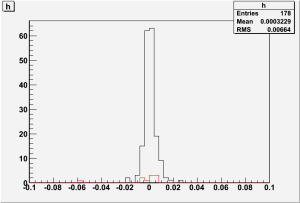I have examined the trending of Pedestals and MIP peaks to check for systematic changes in pmt readouts for pedestals or MIPs. Both calibrations have remained remained fairly stable over time, indicating very little degrading in either the tiles or the circuitry of the ACD. The stability of the calibrations also gives a reasonable idea of how long a particular calibration can be used before being replaced.
Method
I found MIP peak and Pedestal values once every four weeks from week 28 to week 108 (21 data points). I plotted this data against against time units of 10,000 hours. I then fit a straight line to the data. The slope of this line is the rate of change of the calibration per 1.14 years, so by dividing by 1.14 we find the change per year
MIP peaks
The MIP peak values exhibit no systematic drift. The plots below show histograms of the slope of the trend line (The left in units of MIP's per year, and the right in units of raw PHA per year).
As is apparent from the plots, the MIP peaks are quite stable, to within about 4 percent of a MIP per year. The is no indication of any systematic degrading. The Gaussian distribution of the trends suggests that the appearance that some individual tiles are trending down is more likely due to noise than to any degrading of particular tiles. The mean of the trends is even slightly positive. The only possible systematic effect is demonstrated by the red bars on both plots. These bars are the data from the eight PMT's attached to the four large bottom tiles on the sides. As can be seen, all eight of these PMT's are trending downward. Due to their larger size, these tiles may be degrading more quickly than the others. However, this degrading is again at it's maximum around 4 percent of a MIP per year, and could easily be noise, as these tiles are not outside the Gaussian at all, simply concentrated on one side of it.
Pedestals
Even though the MIP peaks are quite stable, there is still a possibility that since the MIP peaks are pedestal subtracted, downward trending pedestals could mask degrading tiles. However, the pedestals are also very stable (much more stable than the MIP peaks in fact), thus indicating that this is not the case. Below are histograms of the Pedestals (The left is in units of fraction of the pedestal per year, the right in raw PHA per year).
As can be seen above, there is very little drift in the pedestals at all, indicating that the MIP peaks are indeed stable, and are not being masked be pedestal drift. The data is again very Gaussian, indicating that slight drifts are due to noise, not actual degrading. The red boxes in the left histogram are the eight PMT's on the large tiles, indicating that the possible drift in the MIP peaks in these tiles is not apparent in the pedestals. Thus if the drift in those MIP peaks is indeed signal and not noise, the slight degrading is likely in the tiles, not in the electronics of the PMT. But again, there is no indication that it is large enough to worry about.



